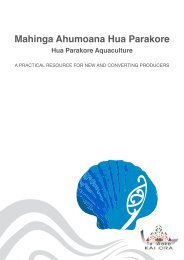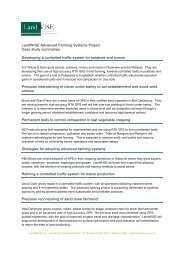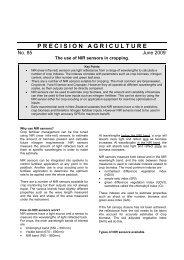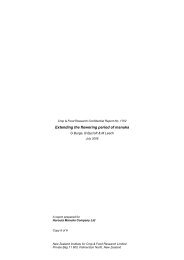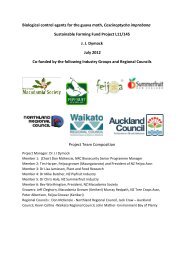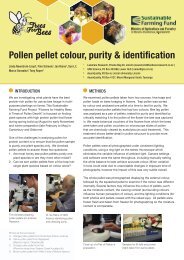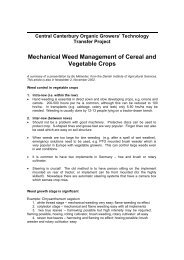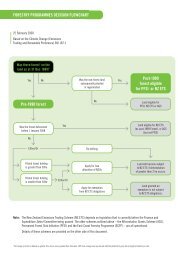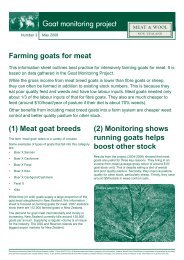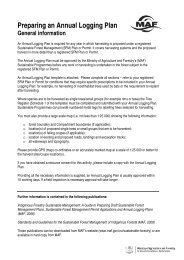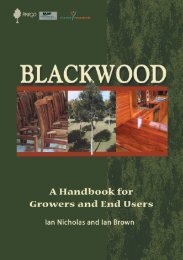Hawkes Bay Winegrowers Booklet
Hawkes Bay Winegrowers Booklet
Hawkes Bay Winegrowers Booklet
You also want an ePaper? Increase the reach of your titles
YUMPU automatically turns print PDFs into web optimized ePapers that Google loves.
HAWKE’S BAY<br />
WINEGROWERS INC.<br />
Energy Efficiency in the Vineyard<br />
A series of Case Studies<br />
• Fuel Efficient Spraying Practices<br />
• Vigour Management & Fuel Efficiency<br />
• Irrigation Management<br />
• Frost Control Energy Efficiency<br />
• Low, Medium & High Vigour Vineyards<br />
This research was commissioned by the<br />
Hawke’s <strong>Bay</strong> Focus Research Group as<br />
part of the Sustainable Farming Fund<br />
Climate Change project.<br />
1
162<br />
CONTENTS<br />
Page 2<br />
Introduction<br />
Page 3<br />
Spraying -Fuel Efficient<br />
Practices.<br />
Page 5<br />
Vigour Management and<br />
Fuel Efficiency<br />
Page 7<br />
Irrigation -Energy<br />
Efficent Practices<br />
Page 9<br />
Frost control -Energy<br />
Efficiency<br />
Page 11<br />
Energy use at Gimblett<br />
Road Vineyard<br />
(low vigour Vineyard)<br />
Page 13<br />
Energy use at Prospect<br />
Vineyard<br />
(med vigour Vineyard)<br />
Page 15<br />
Energy use at Fernhill<br />
Vineyard<br />
(high vigour Vineyard)<br />
These case studies were<br />
written by Carla Emms of<br />
AgFirst as part of the<br />
MAF Sustainable Farming<br />
Fund Project #C08-025.<br />
For more information on<br />
the project, please visit the<br />
MAF SFF website<br />
www.maf.govt.nz/sff or<br />
contact Hawke’s <strong>Bay</strong><br />
<strong>Winegrowers</strong> Inc.<br />
PO Box 1174, Hastings<br />
Phone 06 876 3418<br />
Info@winehawkesbay co.nz<br />
Extra copies of this booklet<br />
are available from Hawke’s<br />
<strong>Bay</strong> <strong>Winegrowers</strong> Inc or<br />
go to www.winehawkesbay.<br />
co.nz to download a copy of<br />
the Individual fact sheets from<br />
the research section using the<br />
members login.<br />
INTRODUCTION<br />
In 2008, the Hawke’s <strong>Bay</strong> <strong>Winegrowers</strong> Focus Research Group began a Sustainable<br />
Farming Fund project looking at the impacts of a climate change on winegrowing in the<br />
region. Whatever your thoughts are about climate change, I think we would all agree<br />
that the climate is changing but to what degree is uncertain and the challenge is how to<br />
practically apply this climate change stuff to our vineyards...<br />
Year 1 of the project involved a series of workshops and seminars to determine how<br />
growers might adapt to a different climate and what the effects may be on future water<br />
availability, pests and diseases, production, and other factors. Year 2 of the project has<br />
then focused on ways to reduce energy use on the vineyard. Energy reduction is using<br />
less fuel, less electricity and means less cost for your business. It is also better for the<br />
environment, through reduced emissions and natural resources while promoting a clean<br />
green image for our region.<br />
The benchmarks are constantly being set higher for producing quality wine – for wine<br />
growers in Hawke’s <strong>Bay</strong> this often means greater inputs; time, expense, and energy. It is<br />
therefore important to look for the most efficient means of producing high quality grapes.<br />
A lot can be learnt from ‘looking over the fence’ and talking to other growers about what<br />
they are doing however, with the demands of day to day vineyard management, this is<br />
often overlooked. Therefore this project is designed to distribute information by profiling<br />
six local vineyards and what they are doing to reduce energy use and expenditure.<br />
The following series of seven short case studies is the outcome of Year 2 of the project.<br />
The case studies were written by Carla Emms of AgFirst and their aim is to profile simple<br />
and cost effective ways of reducing energy use in Hawke’s <strong>Bay</strong> vineyards.<br />
Four case studies concentrate on specific topics:<br />
• Spraying<br />
• Vigour Control<br />
• Irrigation Management<br />
• Frost Management<br />
The remaining ones look at overall vineyard energy use and practices on 3 vineyards:<br />
• Fernhill Holdings Gimblett Road Vineyard (low vigour vineyard)<br />
• Prospect Vineyard ( medium vigour vineyard)<br />
• Fernhill Holdings Fernhill Vineyard (high vigour vineyard)<br />
The vineyards profiled are not necessarily the most energy efficient properties we have<br />
in Hawke’s <strong>Bay</strong>, but are practicing some methods and techniques that could be used<br />
by other growers to reduce energy use and expenditure. The case studies also present<br />
industry average figures, compare costs, present ‘take home messages’, and where to<br />
find further information.<br />
I would like to give a big thanks all the vineyard staff and owners profiled in the case<br />
studies; Phil Holden, Steve Wheeler, Larry Morgan, Dakin Andersen, Tony Purdie, and<br />
Chris Howell, as well as Mike Lane and the Hawke’s <strong>Bay</strong> <strong>Winegrowers</strong> Focus Research<br />
Committee, for their input and feedback.<br />
I suggest you look at this booklet and see where you can apply some energy savings to<br />
your vineyard and do your bit for climate change and you might just save a buck or two<br />
along the way.<br />
Gus Struthers<br />
Chairman<br />
<strong>Hawkes</strong> <strong>Bay</strong> Focus Research Group<br />
HAWKE’S BAY<br />
WINEGROWERS INC.<br />
Front cover photo courtesy of Howard Roberts
FUEL-EFFICIENT SPRAYING PRACTICES<br />
Phil Holden, Vineyards<br />
Manager for 120 ha of Villa<br />
Maria’s super premium and<br />
reserve vineyards on the<br />
Gimblett Gravels in Hawke’s<br />
<strong>Bay</strong>, knows a thing or two<br />
about spraying.<br />
The main feature of Phil’s spray programme is the use of low<br />
water rates. The maximum water rate he uses is just 250 litres/<br />
ha, which not only saves time, but also is more fuel and cost<br />
efficient. This water rate is also well matched to the vineyards<br />
he operates, all of which are low vigour sites with ‘thin’ canopy<br />
volumes.<br />
LOW WATER RATES<br />
SAVE FUEL<br />
The table below shows the effect of water rate on fuel use and<br />
cost of spraying on one of Phil’s vineyards; Ngakirikiri. This<br />
vineyard is 23 ha, planted at 1.8m x 1.6m, and sprayed using a<br />
4-row Pellenc with a 2000L tank at a speed of 7.3 km/hr.<br />
Effect of water rate on spraying fuel use and cost at<br />
Ngakirikiri Vineyard (23ha)<br />
Water rate (l/ha) 250 500 750<br />
Tanks required 3 6 9<br />
Fuel use per app (l) 87 108 129<br />
Annual fuel use (l) 1042 1294 1546<br />
Annual fuel cost ($) $1084 $1346 $1608<br />
% Increase cf 250 - 24% 48%<br />
The key message is that lower water rates use less fuel, as<br />
fewer tank refills are required, meaning less travel and time<br />
and thus lower fuel use. The data shows that by using 500 l/ha<br />
as opposed to 250 l/ha, fuel use and cost is increased by 24%,<br />
and even more when labour savings are taken into account.<br />
“The huge advantages for us are the efficiency and the time<br />
savings,” says Phil.<br />
However, when using lower water rates it is crucial to ensure<br />
sufficient coverage. While high water rates can drench canopies<br />
past the point of run-off, resulting in spray wastage, low water<br />
rates can result in insufficient coverage if canopies are dense<br />
or sprayer set up is incorrect.<br />
With any sprayer, set up is crucial.<br />
As water rates get lower (Phil uses<br />
rates well below 250 l/ha) you<br />
need to be hitting the target. So<br />
like Phil, invest time in perfecting<br />
and checking sprayer set up and<br />
coverage.<br />
Phil has the advantage of ‘thin’ low vigour canopies, which<br />
are easy to get spray coverage into the inner canopy. He also<br />
adds a super spreader and spends a lot of time perfecting and<br />
checking the sprayer set up.<br />
“We are happy with the air-shear nozzle technology and its<br />
coverage and droplet size,” says Phil.<br />
He uses Surround® as a visual test of sprayer setup and also<br />
parks the rig in a row prior to spraying to feel where the airflow<br />
is being directed. 60% is directed at the bunch zone and 40%<br />
into the rest of the canopy.<br />
Advantages of lower water rates<br />
• Faster spraying means lower labour costs or that staff<br />
are freed up for other tasks<br />
• Less fuel is used, which saves money<br />
• Less water is consumed<br />
• The vineyard has a lower carbon footprint<br />
MULTI-ROW MACHINERY AND<br />
FUEL USE<br />
Phil operates two types of machines across the 120 hectares<br />
of vineyards; a 2-row Silvan G2 in combination with a 75 hp<br />
Deutz tractor, and a 4-row Pellenc (106 hp).<br />
Whilst multi-row equipment is often more efficient as it<br />
covers more ground in the same time, it can actually be more<br />
inefficient in terms of fuel use depending on engine power.<br />
The following table compares the efficiency of Phil’s two<br />
systems at Ngakirikiri at a water rate of 250l/ha.<br />
2-row vs. 4-row sprayer at Ngakirikiri (23ha)<br />
Spray Rig<br />
+Tractor<br />
2-row Silvan<br />
Deutz<br />
Horse Power 75 106<br />
Fuel use (l/hr) 7 14<br />
Spraying (hrs) 22 10.5<br />
Fuel use per app (l) 154 147<br />
Fuel use per app (l/ha) 6.7 6.4<br />
Annual fuel use (l) 1848 1764<br />
% Difference - -5%<br />
4-row Pellenc<br />
N/A<br />
While the 4-row Pellenc cuts spraying time by more than<br />
half, with its 106 horsepower engine it actually uses a similar<br />
amount of fuel per hectare as the 2-row Silvan and Deutz<br />
combination. So while there are savings for Phil in labour, fuel<br />
use is similar between the 2-row and 4-row rigs.<br />
3
Although spraying is<br />
completed in under half<br />
the time, the 4-row sprayer<br />
actually uses a similar<br />
amount of fuel to the 2-row<br />
rig at Ngakirikiri.<br />
For medium sized vineyards, a 3-row sprayer may be an<br />
economical intermediate option. The table below calculates<br />
estimated fuel use if the same 75 hp Deutz tractor was used at<br />
Ngakirikiri, using a 3-row sprayer, as opposed to the 2-row rig,<br />
or 4-row set up.<br />
2-row vs. 3-row vs. 4-row fuel use<br />
Spray rig<br />
+ tractor hp<br />
2-row<br />
w75<br />
3-row<br />
75<br />
The calculated annual fuel use for a 3-row sprayer used at<br />
Ngakirikiri would be 1428 litres – a 23% saving compared to<br />
the 2-row sprayer towed by the same tractor. These figures<br />
are important to calculate before you invest in new vineyard<br />
machinery – bigger isn’t always better.<br />
FEWER SPRAY PASSES<br />
SAVE FUEL<br />
4-row<br />
106<br />
Fuel use (l/hr) 7 7 14<br />
Spraying time (hrs) 22 17 10.5<br />
Fuel use per app (l) 154 119 147<br />
Annual fuel use (l) 1848 1428 1764<br />
% difference cf 2-row - -23% -5%<br />
Did you know?<br />
The average expenditure on fuel in Hawke’s <strong>Bay</strong> in<br />
2008/09 was $406 per hectare. For a 23 ha vineyard<br />
such as Ngakirikiri, this equates to $9,340 per year. Do<br />
you know how much fuel is costing you per year on<br />
your own vineyard, and how does this compare to the<br />
average?<br />
Whilst the weather, pest and disease pressure and variety<br />
grown will ultimately determine the number of spray passes<br />
on your vineyard, minimising spray applications will save fuel.<br />
Careful and thorough monitoring of pest and disease levels to<br />
justify spraying is best practice.<br />
Where possible, use tank mixes (read product label<br />
recommendations first) or consider using fertigation to apply<br />
nutrients instead of separate foliar applications. With the<br />
move towards softer late season chemistry we may be doing<br />
more spray passes so application efficiency is crucial.<br />
OTHER TIPS FOR SAVING FUEL<br />
There are other techniques that can be used to save fuel, which<br />
cost little or nothing. Phil takes advantage of these techniques<br />
where he can.<br />
• Using the economy pto when full horse power is not<br />
required. This reduces engine rpm and thus fuel use.<br />
• Keeping tractor tyres inflated at the optimum inflation<br />
pressure. Lower pressures are better for soft ground,<br />
while higher pressures are more suited to hard surfaces.<br />
• Manage tractor idling. Unless the tractor engine is turbo<br />
charged, idling for more than 20 seconds is wasteful, as<br />
‘start-up’ fuel uses no more fuel than about 15 seconds of<br />
idling time.<br />
• Match tractor size to task. Use smaller horsepower<br />
engines for tasks that have light load applications.<br />
Take home messages<br />
• Lower water rates save time and fuel, but match<br />
water rates to canopy size/density<br />
• Spreaders/stickers can help<br />
• Correct sprayer set-up and calibration is crucial, try<br />
Surround/water sensitive paper<br />
• Multi-row machinery is not always more fuelefficient.<br />
Before investing in new machinery,<br />
research its fuel use and run calculations for your<br />
own vineyard<br />
• Minimise spray passes when possible, use<br />
monitoring-based (not calendar) spraying<br />
• Take advantage of low-cost techniques to save fuel<br />
such as optimising spray route, using economy<br />
ptos, managing idling, etc<br />
For further information<br />
Report: Carbon footprinting for wine supply chain<br />
(login on NZ <strong>Winegrowers</strong> website, then under<br />
‘research’): www.nzwine.com<br />
Sustainable Winegrowing NZ website:<br />
www.nzwine.com/swnz (members login, then<br />
technical manual & updates)<br />
Footnote disclaimer: This case study is based upon the best information<br />
available at the time of writing and due care was exercised in its preparation.<br />
AgFirst Consultants HB Ltd and all parties under the SFF project C08-025<br />
disclaim any liability in respect of losses or damages arising out of the use of<br />
this information or in respect of any actions taken in reliance upon the validity<br />
of the information contained herein.<br />
164<br />
This case study was written by Carla Emms, AgFirst, with funding from<br />
MAF Sustainable Farming Fund and Hawke’s <strong>Bay</strong> <strong>Winegrowers</strong><br />
HAWKE’S BAY<br />
WINEGROWERS INC.
VIGOUR MANAGEMENT AND FUEL EFFICIENCY<br />
In this case study, Steve<br />
Wheeler, Senior Viticultural<br />
Services Manager for 1000<br />
ha of Pernod Ricard’s<br />
vineyards in Hawke’s <strong>Bay</strong>,<br />
shares his experience with<br />
vigour control and canopy<br />
management.<br />
A number of vineyards in Hawke’s <strong>Bay</strong> spend significant time<br />
and money dealing with problems created by high vigour. So<br />
what are some alternatives to our standard practices and how<br />
do these compare in terms of cost and fuel use?<br />
CHICORY PLANTINGS<br />
Chicory is a perennial broad-leaf herb that is widely used for<br />
stock feed due to its leafy growth. It also has a deep taproot<br />
and the ability to remove large amounts of nitrogen and water<br />
from the soil making it an ideal tool for managing vigour in<br />
the vineyard.<br />
It is sown in spring or autumn, as either 100% chicory or as a<br />
chicory/grass mix, replacing the traditional grass sward. It is<br />
winter-dormant but grows rapidly from October-April. There<br />
is no vigour effect in the first year of planting as it takes a year<br />
for the roots to establish. Once established it is managed just<br />
as a grass sward would be, and lasts about 3 to 4 years until<br />
re-sowing is required.<br />
Chicory will last longer if every second row is left to flower (not<br />
mowed). Rows can be alternated each year, which ensures a<br />
complete self-seeding programme.<br />
Steve has done some scientific trial work with chicory and<br />
found that it significantly reduced shoot growth rate, leaf<br />
layer number and pruning weights in Cabernet Sauvignon<br />
on a vigorous site. In practical terms, this means that the<br />
number of trimming passes could be reduced from 8 to 6 in<br />
the second and third years. The savings in time, fuel and cost<br />
are quantified in the following table over a 3-year period, from<br />
the time the chicory is sown.<br />
Chicory planted for vigour control in a vineyard. There are other<br />
plants and sward mixes available from horticultural suppliers, that<br />
can do a similar de-vigouring job<br />
Chicory comparison per ha over 3 years<br />
(using own machinery)<br />
Strategy<br />
No chicory<br />
8 trims/yr<br />
This example assumes that you have the machinery to do the<br />
pre-plant cultivation yourself (1x pre-cultivation weed spray<br />
pass, 2x cultivation passes, and 1x rolling pass). Only the cost<br />
of fuel is taken into account, not the full cost of the machinery<br />
(such as operator cost, maintenance and depreciation).<br />
It shows that the cost of establishing chicory (and thus<br />
reducing the number of trimming passes by 25% in years 2<br />
and 3), uses the same amount of fuel, and costs about the<br />
same as trimming alone.<br />
As already mentioned, an alternative would be to let the chicory<br />
flower by only mowing every second row. This way the chicory<br />
can self-seed. This reduces the mowing passes required thus<br />
saving fuel and reducing expenditure. The table below outlines<br />
this scenario over a 5-year period.<br />
Chicory comparison per ha over 5 years<br />
(alternate row mowing)<br />
Chicory<br />
6 trims/yr<br />
Chicory establishment fuel (l) - 40<br />
Trimming fuel (l) 247 206<br />
Total fuel use (l/ha) 247 246<br />
Chicory establishment cost ($) - $40<br />
Trimming cost ($) $247 $206<br />
Total cost ($/ha) $247 $246<br />
Cost difference 0%<br />
Chicory strategy<br />
Mowing strategy<br />
No chicory<br />
Full<br />
Chicory<br />
Full<br />
Chicory<br />
Alternate<br />
Chicory establishment fuel (l) - 40 40<br />
Trimming fuel (l) 494 412 412<br />
Mowing fuel (l) 66 66 33<br />
Total fuel use (l/ha) 560 518 485<br />
Chicory establishment cost ($) - $40 $40<br />
Trimming cost ($) $494 $412 $412<br />
Mowing cost ($) $66 $66 $33<br />
Total cost ($/ha) $560 $518 $485<br />
Cost difference - -8% -13%<br />
This shows that the alternative mowing strategy is both fuel<br />
and cost efficient, reducing fuel use and cost by 13% over<br />
5 years compared to no chicory at all, and chicory with full<br />
mowing. Across an average sized vineyard of 10ha, this<br />
represents a significant saving.<br />
What are the effects of excess vigour?<br />
Overly vigorous grapevines have excessive shoot<br />
growth and dense canopies. This growth creates<br />
extreme shading and leads to problems such as:<br />
• Delayed fruit ripening • Reduced yields<br />
• Poor fruit quality • Higher disease<br />
• Low bud fruitfulness incidence<br />
5
ROOT PRUNING<br />
Root pruning is another method of managing vine vigour.<br />
Blades positioned up to 10cm to 25cm horizontally from the<br />
vine trunk and 40-60cm deep into the soil cut or ‘prune’ vine<br />
roots. This has a limiting effect on vine growth, as the resulting<br />
smaller root area takes up less water and nutrients required<br />
for shoot growth. One or both sides of the row (depending on<br />
vine vigour) can be cut and the reduction in vigour can last for<br />
at least 3 seasons if done well.<br />
One of Steve’s trials with root pruning both sides of the vines<br />
in a vigorous block of Cabernet found that the number of<br />
shoots per vine was reduced by 20%, leaf layer number by<br />
40% and pruning weight by 45%.<br />
“This reduction in vigour translates to a reduction in the number<br />
of trimming passes required over the following 3-year period as<br />
well as other labour savings from faster tucking, pruning and<br />
skirting” says Steve.<br />
So what is the cost and fuel use of undertaking root pruning<br />
and what are the likely results? The table below compares two<br />
scenarios; the first where no root pruning is done, and the<br />
required number of trimming passes per season is 8. The<br />
second scenario assumes root pruning has been done, and<br />
the number of trimming passes required is reduced to 6 per<br />
season. The costs are summed over a 4-year period, which is<br />
the length of time the effect of root pruning can last if done<br />
well.<br />
Root pruning comparison per ha over 4 yrs<br />
Strategy<br />
No root pruning<br />
8 trims/yr<br />
Root pruning fuel (l) - 10<br />
Trimming fuel use (l) 329 247<br />
Total fuel use (l/ha) 329 257<br />
Root pruned<br />
6 trims/yr<br />
FRUIT QUALITY<br />
An example of rootpruning<br />
machinery.<br />
An ‘EM’ soil map<br />
may be a good way of<br />
identifying high vigour<br />
parts of a vineyard<br />
to target with vigour<br />
reduction techniques.<br />
Both vigour control methods outlined above also have<br />
significant effects on the fruit quality through improved brix,<br />
titratable acid, colour and disease control. In dry seasons,<br />
blocks where vigour management strategies, such as chicory,<br />
are being used, may require closer soil moisture monitoring to<br />
ensure the vines are not over water-stressed.<br />
In some cases, root pruning and chicory swards could be<br />
used together as another cost effective vigour management<br />
technique for deep and high water retention soils. This needs<br />
to be investigated further. Mini-baling could be an option to<br />
remove chicory dry matter and take it off site.<br />
Take home messages<br />
• Chicory and root pruning are two effective methods<br />
of managing high vigour<br />
• Both methods reduce the number of trimming<br />
passes required, as well as having other benefits<br />
• Using chicory for vigour control uses the same<br />
amount of fuel as trimming alone<br />
• Using your own machinery for pre-plant preparation<br />
is the best way to keep costs down<br />
• Root pruning can reduce both fuel use and cost by<br />
reducing trimming passes<br />
Root pruning cost ($) - $167<br />
Trimming cost ($) $2274 $1705<br />
Total cost ($/ha) $2274 $1872<br />
Cost difference -18%<br />
The example above compares root pruning with trimming<br />
over a 3-year period (assuming contractor trimming rates). In<br />
this case fuel use was reduced by 22% and total cost by 18%<br />
by root pruning the vines and the resulting drop in trimming<br />
requirement of 25%.<br />
For further information<br />
Steve’s paper on chicory and vigour control:<br />
www.royalsociety.org.nz/Site/publish/Journals/<br />
nzjchs/2005/043.aspx<br />
A conference paper on root pruning:<br />
www.nzwine.com/assets/BSN___Lincoln_University_<br />
Presentation_Paper.pdf<br />
Footnote disclaimer: This case study is based upon the best information<br />
available at the time of writing and due care was exercised in its preparation.<br />
AgFirst Consultants HB Ltd and all parties under the SFF project C08-025<br />
disclaim any liability in respect of losses or damages arising out of the use of<br />
this information or in respect of any actions taken in reliance upon the validity<br />
of the information contained herein.<br />
16<br />
This case study was written by Carla Emms, AgFirst, with funding from<br />
MAF Sustainable Farming Fund and Hawke’s <strong>Bay</strong> <strong>Winegrowers</strong><br />
HAWKE’S BAY<br />
WINEGROWERS INC.
ENERGY-EFFICIENT IRRIGATION PRACTICES<br />
In this case study, Larry<br />
Morgan and Dakin<br />
Andersen from Isosceles<br />
Vineyard share their<br />
experience with energy<br />
efficient irrigation practices.<br />
Isosceles Vineyard is located on Maraekakaho Road, just<br />
out of Bridge Pa in Hastings. The first vines were planted in<br />
2000 on the 15 ha property, which grows predominately white<br />
varieties for premium Te Mata label wines, as well as some<br />
red varieties.<br />
The vineyard is irrigated by an efficient drip system, powered<br />
by an electric pump. The drippers, which each deliver 1.6 l/hr,<br />
are spaced at 600mm intervals down the rows. Along with the<br />
already efficient drip system, Larry and Dakin are using other<br />
technologies and practices to make irrigation management at<br />
Isosceles as energy efficient as possible.<br />
CURRENT ELECTRICITY<br />
USE AT ISOSCELES<br />
The table below shows the current electricity and water use at<br />
Isosceles for the 12 months ended 30 June 2009.<br />
Resource use/ha 08/09 Isosceles HB Average<br />
Electricity (kWh/ha) $156 $271<br />
Difference -42% -<br />
Water Use (mm/total ha) 23 28<br />
(or litres/ha) 230,000 280,000<br />
Difference -18% -<br />
Electricity and water use at Isosceles<br />
The table above shows electricity use at Isosceles was 42%<br />
less than the average in Hawke’s <strong>Bay</strong> in 08/09. Water use is<br />
also 18% less compared to the average for Hawke’s <strong>Bay</strong> in this<br />
season. As well as lowering the vineyards carbon footprint,<br />
reduced energy use is also saving the vineyard money. So what<br />
are Larry and Dakin doing to create this win: win situation?<br />
VARIABLE SPEED DRIVES<br />
SAVE ENERGY<br />
When the property was purchased over 10 years ago, it had an<br />
existing pump and well. However, because it had previously<br />
been used for irrigating large scale annual cropping, the large<br />
37 kWh pump was well in excess of what was required for<br />
irrigating 15 ha of vines. So the decision was made to invest in<br />
a variable frequency drive (also called a variable speed drive)<br />
for the pump.<br />
“Although it cost around $10,000 the variable speed drive was<br />
well worth it for the gains we have in efficiency” says Larry.<br />
Variable speed drives (VSD’s) work by adjusting the pump<br />
speed to match the required pressure. Reducing speed<br />
reduces rpms, and thus also energy use. Many older pumps<br />
were selected to handle maximum future capacities, but if they<br />
don’t need to be run at these levels, a variable speed drive will<br />
reduce energy losses and increase pump efficiency. According<br />
to Victor Mthamo (IrrigationNZ news, September 2009) a<br />
20% reduction in flow will reduce power consumption by 45-<br />
50%.<br />
MONITORING SAVES WATER<br />
AND ENERGY<br />
Monitoring soil moisture levels<br />
After trying different monitoring technologies, Larry has come<br />
back to gypsum blocks. As well as being inexpensive and easy<br />
to use, they provide an accurate measure of soil moisture<br />
status. Dakin monitors 15 sites, with the blocks placed at<br />
varying depths from 100mm to 600mm, that he measures<br />
once or twice a week during the season.<br />
What is a gypsum block?<br />
A gypsum block comprises two electrodes embedded<br />
into a block of porous gypsum. The measurement is<br />
the electrical resistance between the two electrodes,<br />
which varies depending on how much moisture the<br />
block has absorbed from the surrounding soil. The<br />
higher the number, the drier the soil.<br />
Pros and cons of gypsum blocks<br />
Advantages<br />
Inexpensive<br />
Simple to use<br />
Can read very dry soils<br />
Relatively long lasting<br />
Computer compatible<br />
From Dakin’s experience, a reading of 400 means the vines<br />
are approaching the need for irrigation, which also depends<br />
on growth stage and other factors.<br />
Monitoring using<br />
gypsum blocks<br />
is simple, and<br />
inexpensive. Dakin<br />
visits each site,<br />
connecting the logger<br />
box and recording the<br />
results in his notebook.<br />
Disadvantages<br />
Need multiple site and depths<br />
Not good in very stony soil<br />
Not recommended for young vines<br />
Wires can be damaged by hares<br />
‘Once off’ reading, not continual<br />
7
One important aspect of soil moisture monitoring is that you<br />
understand the soil’s characteristics, including different layers,<br />
variations in the block, and waterholding capacity, in order to<br />
interpret soil moisture monitoring readings accurately.<br />
Before the vines were planted, Larry and Dakin dug a number of<br />
soil pits around the site to investigate the soil characteristics.<br />
They found the vineyard (soil classifications Poporangi,<br />
Ngatarawa and Takapau) is various depths of topsoil, over a<br />
silt/sand layer, over gravel. By understanding these different<br />
layers, and how the profile changes across the vineyard, means<br />
Dakin can place soil moisture monitoring devices at different<br />
depths and specific sites and correctly interpret the results.<br />
As well as placing the gypsum blocks at various depths within<br />
the soil profile, Dakin also places some within the row under<br />
drippers, between drippers, and also out in the grass sward.<br />
This gives a good cross-section of data on soil moisture status.<br />
Monitoring vine water levels<br />
Dakin has an ‘indicator block’ of Merlot that he uses to visually<br />
supplement his soil moisture readings. This block is the first<br />
to show signs of water stress. It is important to supplement<br />
soil moisture readings with some kind of vine water stress<br />
measurement, even if it is just visual.<br />
“With gypsum blocks, although you physically have to read every<br />
tube instead of viewing the results over a computer from an office,<br />
visiting the vines gives you a better knowledge of what is happening<br />
out there” says Dakin.<br />
Water budgeting<br />
Water budgeting is a way of keeping track of what water goes<br />
in, and what is lost. A weather station gives Larry and Dakin<br />
an accurate record of rainfall and climatic data and a water<br />
meter records exactly how much water is used. Combining<br />
this information with soil moisture readings and visual vine<br />
water stress observations, this means that irrigation is only<br />
applied at Isosceles when it is actually needed, saving both<br />
energy and water.<br />
Installation of water meters should be regarded as best practice.<br />
How can you manage if you can’t measure?<br />
REGULAR MAINTENANCE<br />
SAVES ENERGY<br />
Dakin invests a lot of time in regular system checks and<br />
maintenance. He has installed easy clean filters, which are<br />
checked weekly, as debris and organic buildup can easily block<br />
emitters and reduce efficiency. He performs regular water and<br />
pressure output measurements, and the whole system gets an<br />
overhaul or servicing annually, including the VSD.<br />
CONCLUSIONS<br />
Easy clean filters<br />
can be checked and<br />
cleaned regularly to<br />
prevent blockages and<br />
maintain irrigation<br />
system efficiency.<br />
Poor irrigation management not only reduces fruit quality<br />
but also can waste water and energy, and cost money. Think<br />
about ways you can more efficiently manage irrigation on<br />
your vineyard – check out the sources below for where to find<br />
further information.<br />
Take home messages<br />
• Efficient irrigation saves money, saves water and<br />
reduces your carbon footprint<br />
• Use variable speed drives if pump capacity is in<br />
excess of that required<br />
• Monitor soil moisture levels, vine status, and<br />
climatic data for water budgeting<br />
• Regular system maintenance is essential<br />
For further information<br />
Irrigation NZ website: www.irrigation.co.nz<br />
Hawke’s <strong>Bay</strong> Regional Council Fact Sheet:<br />
www.hbrc.govt.nz/Publications/EnvironmentTopics/<br />
tabid/244/Default.aspx#water<br />
Sustainable Winegrowing NZ website: www.nzwine.<br />
com/wsnz (members login, then technical manual &<br />
updates)<br />
Local weather stations: www.harvest.com<br />
Footnote disclaimer: This case study is based upon the best information<br />
available at the time of writing and due care was exercised in its preparation.<br />
AgFirst Consultants HB Ltd and all parties under the SFF project C08-025<br />
disclaim any liability in respect of losses or damages arising out of the use of<br />
this information or in respect of any actions taken in reliance upon the validity<br />
of the information contained herein.<br />
168<br />
This case study was written by Carla Emms, AgFirst, with funding from<br />
MAF Sustainable Farming Fund and Hawke’s <strong>Bay</strong> <strong>Winegrowers</strong><br />
HAWKE’S BAY<br />
WINEGROWERS INC.
ENERGY-EFFICIENT FROST CONTROL<br />
In this case study,<br />
Tony Purdie, Vineyard<br />
Manager for Fernhill<br />
Holdings ’Fernhill’<br />
Vineyard shares his<br />
experience with energy<br />
efficient frost control<br />
practices.<br />
Fernhill Vineyard is located on Korokipo Road, just out<br />
of Fernhill in Hastings. Only white varieties are grown;<br />
Chardonnay, Sauvignon Blanc, and Viognier, for Babich wine<br />
labels. Since the early 1990’s the 15 ha property was frostprotected<br />
by just one petrol wind machine until an upgrade to<br />
more efficient technology.<br />
WIND MACHINES<br />
After suffering frost damage to the bottom stop bank half of<br />
the vineyard, Jim Hamilton made the decision to upgrade from<br />
one petrol machine to two new diesel machines in 1999. Both<br />
are Frost Boss machines, one a 2-blade machine and the other<br />
a 4-blade machine. Ten frost pots, strategically placed within<br />
the vineyard, also burn diesel to supplement the protection<br />
provided by the wind machines. The decision to go with diesel<br />
wind machines, as opposed to petrol, was based on fuel and<br />
maintenance charges.<br />
Despite considerable planning and calculation regarding<br />
placement of the two new wind machines, in 2008 the 2-blade<br />
machine was moved 70 metres down the headland as it was<br />
not providing sufficient protection upwind along the southern<br />
boundary. A new pad was built and the machine shifted. At the<br />
same time, the 4-blade machine also had a blade upgrade to<br />
more efficient composite blades.<br />
OVERHEAD SPRINKLERS<br />
Despite two new diesel wind machines, a large part of the<br />
vineyard was still unprotected due to its ‘L’ shape. After severe<br />
frost damage in the unprotected part of the vineyard several<br />
years in a row, the decision was made to put in overhead<br />
sprinklers. These went in during the winter of 2008 and cover<br />
4 ha. This system is driven by a 30 kWh electric pump. As the<br />
vineyard is generally not irrigated, this pump is solely used for<br />
frost protection. There are 351 sprinklers in total, each capable<br />
of emitting 450 litres of water per hour. This gives a total<br />
water output of 157,950 litres per hour (equivalent to 158 cubic<br />
metres, or 3.95 mm, per hour).<br />
FROST CONTROL IN SPRING 2009<br />
The following table shows frost protection figures for Fernhill<br />
Vineyard for the spring of 2009. As well as hours run, the table<br />
also shows total energy used by each system.<br />
Frost control at Fernhill<br />
Frost control 09 Hrs run Energy/<br />
hr<br />
Fernhill used a total of 1215 litres of diesel for frost protection<br />
in 2009, and 1909 kWh of electricity. Both fuel and electricity<br />
contribute to a vineyards carbon footprint, so how do the<br />
different systems compare?<br />
COMPARING EMISSIONS<br />
The following table calculates the relative CO2-equivalent<br />
emissions per hour per hectare for each of the two systems.<br />
This is one method of comparing the two systems as it is<br />
difficult to compare fuel use with electricity use directly.<br />
Fernhill’s comparative emissions<br />
Total<br />
energy<br />
2-blade wind machine 33 15 L 495 L<br />
4-blade wind machine 34 15 L 510 L<br />
Diesel burners 33 6.4 L 210 L<br />
Total diesel<br />
1215 L<br />
Overhead sprinklers 34 56 kWh 1909 kW<br />
Total electricity<br />
1909 kWh<br />
Advantages<br />
2 wind machines<br />
+ diesel burners<br />
Overhead<br />
Sprinklers<br />
Area covered (ha) 11 4<br />
Total time run (hr) 100 34<br />
Total energy used 1215 L 1909 kWh<br />
Energy/hr/ha 1.10 L/hr/ha 14kWh/hr/ha<br />
CO 2<br />
-e/hr/ha 2.87 kg 2.93 kg<br />
Cost/hr/ha $1.10 $3.22<br />
The table shows that the diesel-powered frost protection<br />
system produces similar emissions compared to the overhead<br />
sprinklers, on the same basis. The operation cost is higher for<br />
the overhead sprinklers. However, other resource use must be<br />
considered, such as water and its availability, when comparing<br />
the two systems, as well as site suitability and the relative<br />
costs; both capital and running costs, economic payback<br />
period and return on investment.<br />
What is a carbon footprint and what does it<br />
mean?<br />
A carbon footprint is “the total set of greenhouse gas (GHG) emissions<br />
caused directly and indirectly by an individual, organization,<br />
event or product” (UK Carbon Trust 2008). Carbon dioxide is a one<br />
type of GHG and is emitted through burning energy such as fossil<br />
fuels. Therefore being more energy efficient, the lower your carbon<br />
footprint.<br />
9
INCREASING ENERGY<br />
EFFICIENCY<br />
Why bother increasing energy effiency?<br />
1. To save money through lower energy use and<br />
increase profitability<br />
2. To reduce the impact on the environment by<br />
generating fewer GHG emissions<br />
3. Increase marketing opportunities<br />
So how can we increase energy efficiency in our frost protection<br />
systems?<br />
Start and stop times<br />
One method Tony uses is to set start times as low as possible<br />
without incurring frost damage. Tony’s trigger temperature for<br />
the wind machines is 1.0°C and the overhead sprinkers are<br />
set at 0.8°C. These temperatures will be unique for individual<br />
sites, so growers need to find what these trigger points are for<br />
their own blocks, not just turning on when the neighbours’<br />
systems start.<br />
Tony believes there is room to move these trigger temperatures<br />
lower at Fernhill, particularly for the overhead sprinklers, as he<br />
becomes more familiar with operating the systems. For every<br />
extra hour the wind machines operate, they use an additional<br />
30 litres of fuel between them.<br />
The 4-blade machine at Fernhill<br />
Vineyard uses approximately 15<br />
litres of diesel per hour. As well<br />
as using extra fuel and costing<br />
more, unnecessary running of<br />
wind machines can result in noise<br />
complaints from neighbours<br />
Regular servicing<br />
As well as calibrating temperature probes, Tony highlights the<br />
need to keep frost protection systems well maintained and<br />
serviced regularly for optimum efficiency, just like any other<br />
mechanical gear such as tractors and vineyard machinery.<br />
Tony gets both wind machines serviced annually, and the<br />
overhead sprinkler system is flushed each year in August. In<br />
addition, the sprinklers are removed before the nets go on for<br />
inspection and cleaning. The filter is also given a good clean to<br />
prevent sand from getting into the lines and emitters.<br />
OPTIONS FOR THE FUTURE<br />
Tony is keen to look into the possibility of using alternative<br />
fuels to power the wind machines and diesel burners in the<br />
future. This could include vegetable oil-based biodiesel or<br />
hydrogen as alternative, low emission, fuel sources.<br />
Solar panels are available for wind machines to trickle charge<br />
their batteries, which are vital to keep charged through the<br />
entire season. Any method of making frost protection more<br />
energy efficient will save money and reduce vineyard carbon<br />
footprint.<br />
Take home messages<br />
• Energy-efficient frost protection saves money and<br />
reduces your carbon footprint<br />
• Optimise start and stop times specific to your own<br />
vineyard site<br />
• Use temperature loggers/lights to identify<br />
temperature gradients in the vineyard<br />
• Keep equipment and technology calibrated and<br />
regularly serviced<br />
Accurate temperature monitoring<br />
Accurate monitoring of temperature is also important to<br />
determine accurate start and stop times. Tony uses an exposed<br />
temperature probe in the block and an alarm is triggered to call<br />
his mobile once the temperature gets down to 2°C. Fernhill has<br />
a policy of ‘someone on site’ when frost protection systems<br />
are operating. Tony also keeps an eye on temperatures using<br />
temperature lights, which change colour as the temperature<br />
moves. These are placed strategically in different parts of the<br />
vineyard to monitor the temperature differential. Certain parts<br />
of a site will usually be colder than others, so it is important to<br />
be aware of this and adjust your frost protection accordingly.<br />
For further information<br />
Irrigation NZ website:www.irrigationnz.co.nz<br />
Hawke’s <strong>Bay</strong> Regional Council Fact Sheet: www.hbrc.<br />
govt.nz/Publications/EnvironmentTopics/tabid/244/<br />
Default.aspx#water<br />
Sustainable Winegrowing NZ website:<br />
www.nzwine.com/swnz (members login, then<br />
technical manual & updates)<br />
Local weather stations: www.harvest.com<br />
Footnote disclaimer: This case study is based upon the best information<br />
available at the time of writing and due care was exercised in its preparation.<br />
AgFirst Consultants HB Ltd and all parties under the SFF project C08-025<br />
disclaim any liability in respect of losses or damages arising out of the use of<br />
this information or in respect of any actions taken in reliance upon the validity<br />
of the information contained herein.<br />
16 10<br />
This case study was written by Carla Emms, AgFirst, with funding from<br />
MAF Sustainable Farming Fund and Hawke’s <strong>Bay</strong> <strong>Winegrowers</strong><br />
HAWKE’S BAY<br />
WINEGROWERS INC.
ENERGY USE AT GIMBLETT ROAD VINEYARD<br />
Fernhill Holdings Gimblett<br />
Road Vineyard is managed<br />
by Tony Purdie. The 35 ha<br />
property is located on the<br />
Gimblett Gravels and grows<br />
predominantly Chardonnay,<br />
Merlot, Cabernet Sauvignon<br />
and Syrah.<br />
Fuel use at Gimblett Road<br />
This case study looks into energy use at Fernhill Holdings<br />
Gimblett Road Vineyard, current energy saving practices that<br />
are being used now, and potential techniques that could be<br />
implemented in the future.<br />
All data presented in<br />
this case study is from<br />
the 2009 vintage (the<br />
12 months ended<br />
30 June 2009). All<br />
monetary figures are<br />
GST exclusive.<br />
Quick facts<br />
Planted area: 35 ha<br />
Vine spacing: 2.73m x 2.0m<br />
Row distance/ha: 3.663 km<br />
Canopy: Spur VSP<br />
Vigour<br />
Low<br />
Electricity use<br />
Running the irrigation pump consumes the majority of<br />
electricity at Gimblett Road Vineyard. In 2008/09 the vineyard<br />
received 108mm of irrigation, using 13835 kWh of electricity.<br />
A fertigation unit is also linked up to the system to deliver<br />
nutrients to the vines while being irrigated.<br />
CURRENT ENERGY USAGE<br />
A range of energy is currently used at Gimblett Road. The<br />
vineyard uses diesel, petrol, oil and electricity, which are<br />
outlined in the table below.<br />
Annual energy usage at Gimblett Road<br />
COMPARISON TO OTHER<br />
VINEYARDS<br />
The table below compares Gimblett Road’s energy costs per<br />
hectare with industry benchmarks (MAF Farm Monitoring,<br />
2008/09).<br />
Energy type Vineyard use Annual use<br />
Diesel tractor operations, utes 5394 l<br />
Petrol quad bike 400 l<br />
Jet fuel helicopter frost protection 2185 l<br />
Oil tractor, vehicles 70 l<br />
Electricity irrigation, office 13835 kWh<br />
FUEL USE<br />
Annual fuel and oil use on the vineyard in 2008/09 was 8049<br />
litres. The majority of this was diesel (67%), followed by petrol<br />
(5%), and oil at 0.9%. A helicopter also flew for frost protection<br />
for 19 hours in spring 2009, which used an estimated 2185<br />
litres of jet fuel, which accounts for 27% of total fuel use.<br />
In terms of fuel use by task/machinery, the two vineyard utes<br />
were the largest users of fuel at 41% of total fuel. This was<br />
followed by spraying (9%), mulching (6%), and petrol for the<br />
quad bike (5%).<br />
“While our energy use is often driven by a budget, it is also<br />
about the environment and started with Jim Hamilton’s<br />
commitment to sustainable winegrowing a long time ago.”<br />
Tony Purdie, Gimblett Rd Vineyard<br />
These figures show that Tony’s total expenditure on energy<br />
use is a huge 61% lower than Hawke’s <strong>Bay</strong> industry average.<br />
So how does he achieve this?<br />
CURRENT ENERGY SAVING<br />
TECHNIQUES<br />
Tony is currently using a range of vineyard management<br />
practices that are saving him fuel and money. One such practice<br />
is his spray application strategy for the vineyard.<br />
11
Minimising spray applications<br />
The average number of spray passes applied at Gimblett<br />
Road across all varieties in 2008/09 was just 6.5 applications.<br />
Some blocks, including Sauvignon Blanc, Cabernet Franc<br />
and Cabernet Sauvignon received just 5 applications. The<br />
maximum number of spray passes was 8, for one block of<br />
Merlot and Syrah.<br />
While this may not be typical of every season, every spray<br />
application uses over 100 litres of fuel, so fewer passes<br />
means less fuel consumption and lower costs, in addition to<br />
the savings from using less spray products. The table below<br />
calculates the savings at Gimblett Road in 2008/09 as a result<br />
of using just 6.5 applications.<br />
Impact of spray passes on fuel use<br />
Annual spray apps Fuel used (l) cf Gimblett Rd<br />
Gimblett Rd (avg 6.5) 686 -<br />
8 applications 844 +23%<br />
10 applications 1055 +54%<br />
12 applications 1266 +85%<br />
Tony highlights that careful pest and disease monitoring is<br />
necessary, and an average as low as 2008/09 can’t be achieved<br />
in all seasons. The long-term average is probably closer to 9<br />
applications. In 08/09 he also did have some powdery mildew<br />
in the canopy.<br />
Tony also matches his water rates with canopy size. His<br />
standard water rate is 250 litres/ha, apart from mealy bug<br />
sprays (1000 l/ha) and late season soft botryticides. Lower<br />
rates save fuel, as fewer re-filling trips are required.<br />
Matching engine size to the task<br />
Tony has 3 tractors at Gimblett Road, ranging from 75<br />
horsepower, down to just 50 horsepower. The larger engines<br />
are used for tasks such as mulching and trimming, while the<br />
smaller engines are used for less demanding tasks such as<br />
canopy spraying and weed spraying. By matching engine size<br />
to task requirement saves fuel. Tony also takes advantage of<br />
the economy pto settings in the two larger tractors, which<br />
allows him to reduce engine rpm, thus saving fuel.<br />
Fertigation<br />
The soil type at Gimblett Road is Class 1 Omahu – a gravelly<br />
soil with low water holding capacity and often low nitrogen<br />
levels. Tony addresses this issue though an efficient drip<br />
irrigation system with added fertigation unit. By applying<br />
nutrients through the existing irrigation system, the additional<br />
energy is minor compared to broadcast application using a<br />
tractor or similar.<br />
Bird protection<br />
Unlike many other vineyards in Hawke’s <strong>Bay</strong>, Gimblett Road<br />
does not use bird netting to protect the crop near harvest.<br />
While this would not be practical in other vineyards, not having<br />
nets saves a considerable amount of time, fuel and cost.<br />
The estimated fuel savings from not applying nets at Gimblett<br />
Road is estimated by Tony to be close to 100 litres per ha.<br />
Other energy saving techniques<br />
Tony uses the quad bike as a run-about vehicle around the<br />
vineyard instead of using the ute. He has sheep in over winter<br />
to control weeds, particularly fathen, which also saves him one<br />
weedspray pass. Soil moisture is monitored and recorded<br />
during the season for careful irrigation scheduling. All of these<br />
factors help to reduce energy usage at Gimblett Road.<br />
ENERGY SAVING OPTIONS FOR<br />
THE FUTURE<br />
Improving energy efficiency is an ongoing goal. Below are<br />
some of the possible options Tony could consider to achieve<br />
this.<br />
Tony’s energy reduction ideas<br />
• The number of vineyard utes has since been reduced<br />
from two to one<br />
• Replacing the use of helicopters for frost protection<br />
with overhead sprinklers<br />
Other possibilities<br />
• Pursue the supply of bio-diesel locally<br />
• Consider using sheep for leaf plucking<br />
• Look at a 2-row weedsprayer<br />
Take home messages<br />
• Reduce spray passes where possible<br />
• Match engine size/rpm to task<br />
• Take a look at your own energy use figures and<br />
compare these against Tony’s<br />
For further information<br />
MAF Viticulture Monitoring Figures: www.maf.govt.<br />
nz/mafnet/rural-nz/statistics-and-forecasts/farmmonitoring/2009/horticulture/<br />
Footnote disclaimer: This case study is based upon the best information<br />
available at the time of writing and due care was exercised in its preparation.<br />
AgFirst Consultants HB Ltd and all parties under the SFF project C08-025<br />
disclaim any liability in respect of losses or damages arising out of the use of<br />
this information or in respect of any actions taken in reliance upon the validity<br />
of the information contained herein.<br />
16 12<br />
This case study was written by Carla Emms, AgFirst, with funding from<br />
MAF Sustainable Farming Fund and Hawke’s <strong>Bay</strong> <strong>Winegrowers</strong><br />
HAWKE’S BAY<br />
WINEGROWERS INC.
ENERGY USE AT PROSPECT VINEYARD<br />
Prospect Vineyard is a family-owned<br />
vineyard just out of Bridge Pa in<br />
Hawke’s <strong>Bay</strong>. It was established in<br />
1995 by Chris and Catherine Howell<br />
and grows predominately Merlot<br />
as well as some Cabernet Franc,<br />
Syrah, Chardonnay, and Semillon<br />
Fuel use at Prospect<br />
This case study looks into energy use at Prospect Vineyard,<br />
current energy saving practices that are being used now, and<br />
potential techniques that could be implemented in the future.<br />
All data presented in this case study is from the 2009 vintage<br />
(the 12 months ended 30 June 2009). All monetary figures are<br />
GST exclusive.<br />
Quick facts<br />
Planted area:<br />
12.35 ha<br />
Vine spacing: 2.4m x 1.8m<br />
Row distance/ha: 4.167 km<br />
Canopy:<br />
2-cane VSP<br />
Vigour<br />
medium<br />
CURRENT ENERGY USAGE<br />
A range of energy types is currently used at Prospect. This<br />
includes diesel, petrols, gas and electricity, which are outlined<br />
in the table below.<br />
Electricity use<br />
Running the irrigation pump consumes the majority (76%) of<br />
electricity at Prospect. In 2008/09 the 19 kWh pump ran for a<br />
total of 87 hours, using 9660 kWh of electricity. The remainder<br />
is a small amount to power the home office and sheds.<br />
COMPARISON TO OTHER<br />
VINEYARDS<br />
The table below compares Prospect’s energy costs per hectare<br />
with industry benchmarks (MAF Farm Monitoring, 2008/09).<br />
Annual energy usage at Prospect<br />
Energy type Vineyard use Annual use<br />
Diesel tractor operations, ute,<br />
frost pots, pumping water<br />
for frost protection<br />
3028 l<br />
Petrol (91) wind machine, quad bike 993 l<br />
Petrol (96) car 789 l<br />
LPG gas guns 28 kg<br />
Oil tractor, vehicles 22 l<br />
Electricity irrigation, office 12773 kWh<br />
Fuel use<br />
Annual fuel and oil use on the vineyard in 2008/09 was 4860<br />
litres. The majority of this was diesel (63%), followed by 91<br />
petrol (20%), 96 petrol (16%), LPG (0.6%), then oil (0.5%).<br />
In terms of fuel use by task/machinery, Chris’s ute was the<br />
largest user of fuel at 27% of total fuel. This is followed by the<br />
diesel frost pots (21%), the car for business use (16%), and<br />
the petrol wind machine (14%). During this season there were<br />
a high number of frost events in Hawke’s <strong>Bay</strong> so fuel use for<br />
frost protection could be considered higher than the long-term<br />
average.<br />
Comparison of energy expenditure<br />
This shows that Chris’s annual spend on energy is 16% below<br />
the industry average for Hawke’s <strong>Bay</strong>. So how does he achieve<br />
this?<br />
CURRENT ENERGY SAVING<br />
TECHNIQUES<br />
Chris is currently using a range of vineyard management<br />
practices that are saving him fuel and money. One such<br />
practice is the use of sheep for leaf plucking.<br />
13
Sheep: 4-legged machines<br />
Chris is definitely an advocate for using sheep in his vineyard.<br />
As well as winter grazing, they also save fuel and cost when<br />
used instead of machines for leaf plucking.<br />
“Not only does using sheep save on fuel,<br />
but they also do a better job than people or<br />
machinery – it’s really a win-win situation.”<br />
Chris Howell, Prospect Vineyard<br />
For leaf plucking, the ewes are trucked to the vineyard in mid<br />
December. Chris fences the vineyard into units by variety,<br />
around one hectare in size. With 200 ewes per one-hectare<br />
unit it takes between 1.5 and 2 days until they need to be moved<br />
to the next unit, depending on the amount of feed available. It<br />
takes around 3 weeks to finish the whole vineyard, after which<br />
the sheep are removed. Chris pays part of the trucking cost to<br />
transport the sheep to and from the property.<br />
Chris highlights the need to be aware of spray use and<br />
withholding periods. In particular he is careful with copper<br />
use as this can be highly toxic to sheep. The animals are also<br />
used to graze the vineyard over winter, providing excellent<br />
sward and weed control. This means one less mowing pass<br />
and weed-spraying pass for Chris. The table below calculates<br />
the total annual savings from using sheep at Prospect – 445<br />
litres of fuel and $1400.<br />
Estimated annual savings from using sheep<br />
Task and estimated saving Fuel (l) Cost ($)<br />
Leaf plucking (vs. mechanical) 330 l $1280<br />
Mowing 80 l $85<br />
Weed spraying 35 l $37<br />
Total 445 l $1402<br />
Matching rpm to the task<br />
Chris uses a 65 hp Same Golden Compatto tractor for all his<br />
vineyard operations. He takes advantage of the 750-economy<br />
pto option in this tractor, which allows him, for example, to run<br />
the engine at 1350 rpm rather than 2000 rpm when spraying.<br />
By running at lower engine revs where possible, Chris saves<br />
fuel.<br />
For spraying, these fuel savings add to roughly 175 litres of<br />
diesel per year, a saving of about 40% of Chris’s potential<br />
spraying fuel bill. Chris also uses the economy pto option<br />
when mowing and weed spraying to reduce engine rpms and<br />
save fuel and cost<br />
Multi-row machinery<br />
One piece of machinery that is saving Chris time and fuel is<br />
his 2-row weed sprayer. It takes just 7 hours to do the vineyard<br />
with this attachment on the tractor, which runs at 1000 rpm.<br />
Fuel use is cut by 50%<br />
Comparison of 2-row vs 1-row weed spraying<br />
Single row Double row<br />
Fuel use (l/hr) 4 4<br />
No. of passes 2 2<br />
Total hours 28 14<br />
Annual fuel use (l) 126 63<br />
Saving - 50%<br />
Other energy saving techniques<br />
Chris regularly uses his pushbike to perform tasks around<br />
the vineyard like pest and disease monitoring. He also tries<br />
to minimize spray passes, with just 8 applications on white<br />
varieties on average. And as frost protection is a significant<br />
use of fuel, Chris has tight start and stop times, and monitors<br />
wet bulb temperatures, saving him an estimated 1.5 hours per<br />
major frost event.<br />
ENERGY SAVING OPTIONS FOR THE<br />
FUTURE<br />
Chris is keen to reduce total energy use at Prospect, while<br />
reducing costs and maintaining fruit quality. Below are some<br />
of the possible options he could consider to achieve this.<br />
Chris’ energy reduction ideas<br />
• Install a weather station on site to minimise use of frost<br />
protection energy<br />
• Investigate the availability of tallow for the diesel frost<br />
pots<br />
• Invest in an under-vine mower to replace weed spraying<br />
• If a future pump upgrade is required, invest in a variable<br />
speed drive<br />
Other possibilities<br />
• Look at sourcing bio-diesel locally<br />
• Reduce travel in the ute and car when possible<br />
• Do fewer spray passes where possible<br />
Take home messages<br />
• Consider using sheep for leaf plucking<br />
• Use the economy pto if you have it<br />
• Multi-row machinery can save time + fuel<br />
• Take a look at your own energy use figures and<br />
compare these against Chris’s<br />
For further information<br />
MAF Viticulture Monitoring Figures: www.maf.govt.<br />
nz/mafnet/rural-nz/statistics-and-forecasts/farmmonitoring/2009/horticulture/<br />
Footnote disclaimer: This case study is based upon the best information<br />
available at the time of writing and due care was exercised in its preparation.<br />
AgFirst Consultants HB Ltd and all parties under the SFF project C08-025<br />
disclaim any liability in respect of losses or damages arising out of the use of<br />
this information or in respect of any actions taken in reliance upon the validity<br />
of the information contained herein.<br />
16 14<br />
This case study was written by Carla Emms, AgFirst, with funding from<br />
MAF Sustainable Farming Fund and Hawke’s <strong>Bay</strong> <strong>Winegrowers</strong><br />
HAWKE’S BAY<br />
WINEGROWERS INC.
ENERGY USE AT FERNIHILL VINEYARD<br />
Quick facts<br />
Planted area:<br />
15 ha<br />
Avg vine spacing: 2.9m x 2.1m<br />
Row distance/ha: 3.484 km<br />
Canopy:<br />
VSP, sylvos<br />
Vigour:<br />
Med-high<br />
This vineyard also features<br />
in the case study on frost<br />
management in this series.<br />
Fernhill Holdings Fernhill<br />
Vineyard is managed by Tony<br />
Purdie. The 15 ha property is<br />
located on Twyford silt loam<br />
soils at Fernhill and grows<br />
Chardonnay, Sauvignon Blanc<br />
and Viognier.<br />
CURRENT ENERGY USAGE<br />
Annual energy usage at Fernhill Vineyard<br />
Energy type Vineyard use Annual use<br />
Diesel tractors, utes, frost protection 5233 l<br />
Petrol quad bike 40 l<br />
Oil tractor, vehicles 20 l<br />
Electricity frost protection, general 2134 kWh<br />
Annual fuel and oil use on the vineyard in 2008/09 was<br />
5293 litres. The majority of this (46%) was diesel for tractor<br />
operations, followed by diesel use in the two vineyard utes<br />
(30%). The vineyard also has 2 diesel-powered wind machines,<br />
supplemented by frost pots, which used around 23% of total<br />
fuel.<br />
Fuel use at Fernhill Vineyard<br />
Total electricity use is very low as the vineyard is not irrigated.<br />
The majority of electricity is used to run the overhead sprinklers<br />
for frost protection in spring.<br />
When comparing Fernhill Vineyard’s energy costs per hectare<br />
with industry benchmarks (MAF Farm Monitoring, 2008/09),<br />
the data shows that Tony’s total expenditure is more than 25%<br />
below average compared to vineyards in Hawke’s <strong>Bay</strong>.<br />
CURRENT ENERGY SAVING<br />
TECHNIQUES<br />
So what techniques is Tony using?<br />
New bird netting application<br />
The entire vineyard at Fernhill is netted each season for bird<br />
protection. Historically this was done using tractors – a<br />
time and fuel consuming exercise. Now, with the help of an<br />
innovative design, the nets are put out using a quad bike, in<br />
half the time, and at less than half of the fuel consumption.<br />
Double-sided trimmer<br />
As a high vigour site, trimming uses a large amount of fuel.<br />
Tony has significantly improved the efficiency of trimming by<br />
investing in a trimmer that trims two sides at a time, compared<br />
to just one.<br />
Mowing alternate rows<br />
Tony has switched to alternate row mowing at Fernhill. This<br />
not only results in fewer passes, but encourages beneficial<br />
insects in the grass sward. Tony also ensures mower blades<br />
are kept sharp and sheep are brought in to graze for frost<br />
protection.<br />
Matching site potential to canopies<br />
It is important to match vine canopies to a sites ‘potential’. This<br />
has been done at Fernhill, with its heavier soils, using wider<br />
vine spacings, different trellis types and canopy management.<br />
Tile drains reduce soil moisture, and chicory has been used in<br />
the past to reduce vine vigour.<br />
Take home messages<br />
• High vigour doesn’t have to = high fuel use<br />
• Take a look at your own energy use figures and<br />
compare these against Tony’s<br />
Footnote disclaimer: This case study is based upon the best information<br />
available at the time of writing and due care was exercised in its preparation.<br />
AgFirst Consultants HB Ltd and all parties under the SFF project C08-025<br />
disclaim any liability in respect of losses or damages arising out of the use of<br />
this information or in respect of any actions taken in reliance upon the validity<br />
of the information contained herein.<br />
HAWKE’S BAY<br />
WINEGROWERS INC.<br />
This case study was written by Carla Emms, AgFirst, it has been<br />
summarised for inclusion in this booklet. For a copy of the full<br />
case study contact Hawke’s <strong>Bay</strong> <strong>Winegrowers</strong> Inc or go to www.<br />
winehawkesbay.co.nz and download a copy from the research section<br />
using the members login.<br />
15
HAWKES BAY’S 2010...<br />
Markhams Young Viticulturist of the Year Competition<br />
& Fruitfed Silver Secateurs Competition in association with<br />
& Hawke’s <strong>Bay</strong> <strong>Winegrowers</strong> Winter Workshop Seminar<br />
EUTYPA MANAGEMENT. Key note speaker Dr Mark Sosnowski<br />
Research Scientist with South Australian Research and Development Institute (SARDI).<br />
Friday 25th June, Mission Estate Winery, Church Road, Taradale<br />
9.00 am Silver Secateurs Competition<br />
*Registrations from 8am on the day<br />
10.00 am Winter Workshop:<br />
Eutypa Management<br />
11.45 am BBQ Lunch provided<br />
12.00 pm Horty Sports<br />
12.30 pm Silver Secateurs Prize Giving<br />
1.30 pm Vineyard Walk and Talk<br />
(with Dr Mark Sosnowski)<br />
6.00 pm Dinner at Mission Estate<br />
Wine Options & Hawke’s <strong>Bay</strong><br />
Young Viticulturist of the Year<br />
speeches. Tickets just $75 each<br />
For more information & dinner tickets contact:<br />
Kathleen at Hawke’s <strong>Bay</strong> <strong>Winegrowers</strong><br />
Phone 06 876 3418 or email info@winehawkesbay.co.nz<br />
The Young Viticulturist of the Year is generously supported by :<br />
Regional Sponsors:<br />
National Sponsors:<br />
Vineyard Plants Ltd<br />
HAWKE’S BAY<br />
WINEGROWERS INC.



